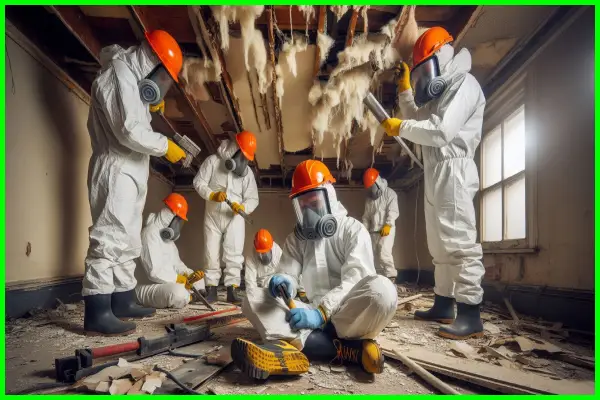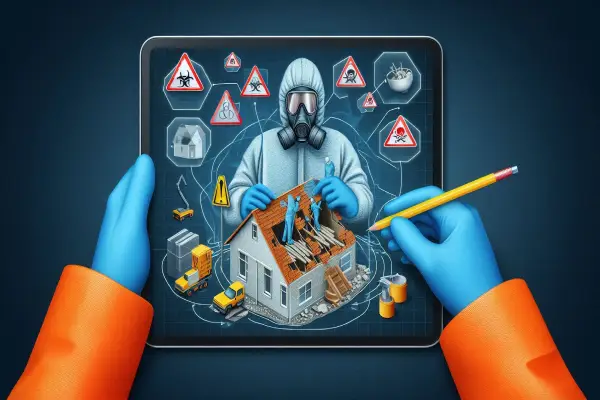Asbestos surveys, including Asbestos Management Surveys and Refurbishment and Demolition Surveys, play a crucial role in ensuring safety in buildings that may contain this hazardous material.
Understanding what an asbestos survey entails, why it’s necessary, and the potential health risks associated with asbestos exposure, including lung diseases and asbestos-related diseases, is vital for property owners and managers.
This guide covers the various types of surveys, the process involved, and the legal implications, helping you make informed decisions regarding asbestos management, materials management, and safety. Understanding the HSE Guidance HSG264 is also crucial for compliance.
Stay informed to protect yourself and others from the dangers of asbestos and the serious diseases it can cause. Ensure that your property has an updated Asbestos Register and follows an effective Asbestos Management Plan.
What Is an Asbestos Survey?
An asbestos surveyor plays a critical role in this process, ensuring that all aspects of asbestos risk are thoroughly evaluated.
An asbestos survey is a crucial process that involves the assessment of asbestos-containing materials in buildings, particularly in the construction industry and for construction purposes, to identify potential health risks related to asbestos exposure.
This survey is carried out to ensure compliance with legal duties set forth by the Control of Asbestos Regulations 2012 in the UK, Northern Ireland, and is typically conducted by a competent surveyor who can accurately identify, manage, and record asbestos materials in a structured manner.
The primary objective is to safeguard both the duty holder and the public by preventing asbestos-related diseases, including serious conditions such as lung cancer and mesothelioma, that can arise from inhalation of fibres during maintenance work or construction work. Regular Asbestos Risk Assessments are essential in this process.
Why Is an Asbestos Survey Necessary?
An asbestos survey is necessary to identify and manage asbestos-containing materials (ACMs) in non-domestic buildings, which pose serious health risks if disturbed during routine maintenance or construction work. The survey helps in developing an effective asbestos management plan that outlines precautions and procedures for handling asbestos, ensuring compliance with legal duties under the Control of Asbestos Regulations, which aim to protect workers and the general public from potential exposure to hazardous materials.
Furthermore, understanding the asbestos risk assessment is vital to mitigate the dangers of inhalation of fibres that can lead to severe health consequences, including lung diseases and asbestos-related diseases such as asbestosis and mesothelioma. Effective risk management and proper safety precautions are critical in this context.
What Are the Health Risks of Asbestos Exposure?
Asbestos exposure poses significant health risks, leading to serious diseases such as mesothelioma, lung cancer, and asbestosis, which result from the inhalation of fibres released from asbestos-containing materials (ACMs). These health consequences can take years, even decades, to manifest, making it crucial for individuals working in or around non-domestic buildings to be aware of the hazards associated with asbestos, particularly in the construction industry where refurbishment and demolition activities may disturb hidden ACMs.
As the danger of asbestos exposure often goes unnoticed, understanding the associated health conditions is imperative. Below are key health issues stemming from asbestos:
- Mesothelioma: A rare but aggressive cancer affecting the lining of the lungs, abdomen, or heart; symptoms may not appear until 20–50 years after exposure.
- Lung Cancer: A common consequence of prolonged contact with asbestos; symptoms often include coughing, chest pain, and difficulty breathing.
- Asbestosis: A chronic lung disease caused by scarring of lung tissue, leading to shortness of breath and persistent coughing.
Recognising the symptoms early and seeking prompt medical attention can significantly improve outcomes. Regular screening and awareness are essential for those potentially exposed, particularly in high-risk occupations. Taking proactive measures can ultimately save lives.
Who Is at Risk of Asbestos Exposure?
Individuals at risk of asbestos exposure include workers in the construction industry, maintenance staff, and duty holders responsible for managing non-domestic buildings containing asbestos-containing materials (ACMs). Those involved in refurbishment or demolition work are particularly vulnerable, as they may inadvertently disturb ACMs, releasing harmful fibres into the air. Inadequate training and lack of asbestos awareness among workers can significantly increase the risk of asbestos-related diseases, underscoring the need for proper safety measures and education to mitigate workplace hazards.
Occupations such as electricians, plumbers, and heating, ventilation and air conditioning (HVAC) technicians often find themselves in situations where they could encounter ACMs, particularly in older buildings. For instance, when these professionals work on insulation materials or ceiling tiles that may contain asbestos, they face a heightened risk. Licensed Asbestos Contractors in London can provide the necessary support and expertise in these scenarios.
- Proper asbestos training courses are essential for these workers to understand the dangers and adhere to safety protocols.
- Competent surveyors play a critical role in identifying and managing risks associated with ACMs, helping ensure that effective safety measures are in place.
- These surveyors help assess the condition of identified materials and provide guidance on protective actions to take, which is paramount for maintaining a safe work environment.
The collaboration of well-trained professionals and knowledgeable surveyors is vital to prevent unnecessary asbestos exposure, thereby protecting the health and safety of all individuals involved in high-risk occupations.
What Are the Legal Requirements for an Asbestos Survey?
Legal requirements for an asbestos survey are established under the Control of Asbestos Regulations 1999, which mandate that duty holders conduct thorough asbestos surveys in non-domestic buildings to identify and manage asbestos-containing materials. These regulations outline the necessary actions to ensure workplace safety and compliance, requiring that surveys be carried out by accredited bodies, such as those certified by UKAS, to maintain the highest standards of asbestos management. This legal framework is essential to protect not only workers but also the general public from the health risks associated with asbestos exposure.
Along with the overarching obligations introduced by these regulations, duty holders are also responsible for developing a comprehensive asbestos management plan that addresses the presence of asbestos in their premises. This includes maintaining accurate records of identified asbestos materials, ensuring proper maintenance and monitoring, and providing relevant training for employees who may encounter such materials during their work.
Failure to comply with these legal responsibilities can result in severe consequences, including substantial fines from regulatory bodies such as the Health and Safety Executive (HSE) and legal liabilities should an incident arise due to negligence. Non-compliance can escalate risks to health, leading to long-term repercussions for workers and broader community health, thus underscoring the importance of a well-documented asbestos management plan.
- Key responsibilities of duty holders include:
- Conducting regular inspections
- Providing adequate training and resources
- Implementing effective risk management strategies
What Does an Asbestos Survey Involve?
An asbestos survey typically involves a systematic process that includes a visual inspection of the premises, sample collection of suspected asbestos-containing materials (ACMs), and laboratory analysis to confirm the presence of asbestos. This comprehensive approach ensures proper risk management and facilitates the creation of a reliable risk management plan.
This comprehensive approach not only aids in identifying hazardous materials but also helps assess the risk associated with them, forming the basis for developing an asbestos management plan that ensures compliance with legal obligations and best practices for workplace safety.
A competent surveyor conducts the survey using established procedures to guarantee accurate results and effective management strategies.
Visual Inspection
Visual inspection is a vital component of any building inspection aimed at identifying hazardous materials. The findings of this inspection are documented in an Asbestos Survey Report, which serves as a critical record.
The visual inspection is a critical initial step in an asbestos survey, where a trained surveyor examines the premises for visible signs of asbestos-containing materials (ACMs) and potential hazards related to their condition. This includes assessing contaminated materials and evaluating public access areas.
This process requires a systematic approach, encompassing a comprehensive review of a variety of building materials, such as insulation, ceiling tiles, and floor coverings. During the inspection, surveyors meticulously analyse and document these materials in the Asbestos Survey Report:
- analyse each material’s condition,
- document any visible deterioration,
- and identify locations where asbestos may be present.
They also take into account factors that might increase the risk of disturbance, focusing on areas likely to undergo maintenance or refurbishment. Effective documentation of findings is paramount; it not only aids in asbestos risk assessment but also serves as a crucial record for future reference and compliance with regulatory standards, such as those outlined in the Control of Asbestos Regulations 2012. Accurate data collection ensures that potential asbestos-containing materials (ACMs) are managed appropriately, safeguarding the health of occupants and workers alike.
Sample Collection
Sample collection is a crucial phase of the asbestos survey process, where identified potential asbestos-containing materials (ACMs) are carefully collected for laboratory analysis to confirm the presence of asbestos. This process, known as bulk sampling, must be conducted by a competent surveyor using proper safety precautions to avoid contamination and ensure accurate results, as the analysis of these samples ultimately determines the risk associated with hazardous materials within the building.
During the sampling procedure, the surveyor employs various techniques that not only enhance efficiency but also minimise the likelihood of exposure to toxic fibres. Surveyor competency plays a crucial role in ensuring these procedures are carried out effectively.
- Utilising personal protective equipment (PPE) like respirators and coveralls is essential to protect oneself.
- Setting up containment areas and using appropriate tools ensures that any disturbances are mitigated effectively, in compliance with construction regulations.
- Proper labelling and documentation of each sample guarantee traceability and reliability during laboratory testing, as required by UKAS accreditation standards.
Once the samples are collected, they are sent to accredited laboratories where comprehensive analyses are performed. This laboratory testing is pivotal as it confirms the existence of asbestos, guiding necessary actions such as asbestos removal, material removal, or encapsulation to safeguard public health and safety. The accreditation body ensures that these laboratories adhere to strict standards.
Laboratory Analysis
Laboratory analysis is the final step in the asbestos survey process, where collected samples undergo rigorous testing to identify the presence and type of asbestos within the samples. This analysis is critical for determining the appropriate course of action regarding the management or removal of asbestos-containing materials (ACMs), ensuring that decisions made are based on accurate data. Asbestos testing is crucial to verify the safety of the environment, as mandated by HSE Guidance HSG264.
The accuracy of results can significantly impact asbestos management strategies, making it essential to utilise accredited laboratories that adhere to strict protocols. These accredited facilities, often recognized by a UKAS accreditation body, rely on methodologies such as:
- Polarised Light Microscopy (PLM)
- Transmission Electron Microscopy (TEM)
- Thermogravimetric Analysis (TGA), a technique used in sampling analysis
- Scanning Electron Microscopy (SEM)
Each of these techniques offers a unique advantage in detecting and quantifying asbestos fibres, and their effective application is paramount to ensure compliance with local regulations and health standards. Accurate laboratory results not only inform the necessary remedial actions but also enhance the safety of workers and the general public by minimising exposure risks associated with ACMs.
What Are the Different Types of Asbestos Surveys?
There are several types of asbestos surveys, each designed to address specific needs and circumstances surrounding asbestos management. These surveys are critical for compliance with the Control of Asbestos Regulations 2012 in the UK. The main types include:
- Asbestos management survey, which helps identify ACMs for ongoing maintenance,
- Refurbishment and demolition survey, which is essential before any structural work,
- Demolition survey, required prior to demolishing a building.
Additionally, a combined survey may integrate aspects of both management and refurbishment surveys to provide a comprehensive understanding of the asbestos risks present. Each of these surveys plays a critical role in developing an effective asbestos management plan tailored to the specific requirements of the property.
Management Survey
The management survey is a type of asbestos survey conducted with the primary objective of identifying and assessing the presence of asbestos-containing materials (ACMs) in non-domestic buildings for ongoing management and maintenance purposes. This survey is essential for formulating an asbestos management plan that outlines procedures and safety measures to protect workers and the public from the risks associated with asbestos exposure, ensuring compliance with legal duties and regulations.
Conducted by experienced professionals, the survey employs a variety of methodologies tailored to the specific characteristics of the building being inspected. Key techniques include visual inspections, sampling, and laboratory analysis to accurately determine the presence and condition of asbestos-containing materials.
- Visual assessments involve examining potential ACM locations, such as ceiling tiles, insulation, and floors.
- Sampling refers to collecting material fragments for in-depth laboratory analysis, confirming the asbestos content.
- Laboratory tests provide critical data that informs the management plan’s development and ensures appropriate risk mitigation strategies are implemented.
The findings from such surveys play a pivotal role in ongoing management efforts, allowing facility managers to take proactive measures in safeguarding health and compliance.
Refurbishment and Demolition Survey
A refurbishment and demolition survey is a specific type of asbestos survey conducted prior to any structural work, including renovations or demolitions, to identify asbestos-containing materials (ACMs) that may be disturbed during the process. This survey must comply with guidelines set by regulatory bodies such as HSE and the Control of Asbestos Regulations.
This survey plays a vital role in safeguarding not only the workers on-site but also the surrounding community. By identifying ACMs, professionals can evaluate the necessary precautions needed, ensuring that appropriate measures are taken to limit exposure. Licensed asbestos contractors in London often conduct these surveys to ensure compliance with local regulations. Key procedures involved in conducting these surveys include:
- Visual Inspections: Thorough examinations of the site to pinpoint potential asbestos materials.
- Sampling and Testing: Collecting samples from identified materials and sending them to accredited laboratories for detailed analysis. This step is critical in ensuring environmental health standards are met.
- Risk Assessment: Evaluating the likelihood of asbestos fibres being released into the air during renovations or demolitions.
- Destruction Inspection: Assessing the need for asbestos removal during the destruction phase of demolition.
Failure to conduct these essential surveys can result in severe health implications, including respiratory diseases such as asbestosis and mesothelioma. Therefore, implementing a comprehensive refurbishment and demolition survey before initiating any construction activities is not just a regulatory requirement, it’s a crucial step in fostering a safe working environment.
Combined Survey
A combined survey integrates aspects of both management and refurbishment surveys, providing a holistic view of asbestos-containing materials (ACMs) within a building.
This approach not only streamlines the assessment process but also enhances compliance with regulations associated with asbestos management. By addressing both the ongoing monitoring and the potential for future construction activities, a combined survey ensures that all aspects of asbestos management are effectively coordinated. This type of survey allows duty holders to:
- Identify and evaluate the presence of ACMs more accurately.
- Mitigate risks by developing tailored action plans for both current and planned works.
- Reduce costs associated with separate inspections and potential delays.
The insights gained from a combined survey facilitate well-considered choices regarding the management and remediation of hazardous materials, ultimately fostering a safer environment for all occupants.
What Happens After an Asbestos Survey?
After an asbestos survey is completed, the findings are documented in an asbestos register, which serves as an essential tool for managing asbestos-containing materials (ACMs) and informing all relevant parties about their locations and condition. This process must meet the standards established by regulatory bodies, including HASpod, Emma, BSc Construction Management, NEBOSH, and Tech IOSH.
The asbestos survey report generated from this register, combined with the results of the risk assessment, aids in the formulation of an asbestos management plan that outlines specific actions and recommendations for addressing ACMs, including potential asbestos removal or management strategies to ensure safe working environments.
Asbestos Register
The asbestos register is a crucial document created after an asbestos survey that records the location, type, and condition of asbestos-containing materials (ACMs) within a building. This register, often detailed in an Asbestos Survey Report, is vital for the ongoing management of ACMs, ensuring that duty holders fulfil their legal duties by keeping all relevant parties informed about the presence of asbestos, outlining necessary actions, and facilitating compliance with safety regulations.
Along with cataloguing information, the asbestos register serves several key functions that enhance workplace safety and compliance. It provides essential data for stakeholders including property owners, maintenance personnel, and health and safety officers, enabling them to make informed decisions regarding disclosure, asbestos risk assessment, and risk management.
It details required safety procedures such as monitoring conditions, conducting regular inspections, asbestos management surveys, and implementing control measures. Integrating seamlessly with the asbestos management plan, the register becomes a living document that assists in the:
- Identification of high-risk areas;
- Planning of appropriate remediation strategies;
- Communication of responsibilities to staff and contractors.
By keeping the register updated, organisations not only ensure adherence to regulations like the Control of Asbestos Regulations 2012 but also promote a culture of safety that protects the health of all individuals who interact with the property.
Asbestos Management Plan
An asbestos management plan is a comprehensive document that outlines the procedures and strategies for managing asbestos-containing materials (ACMs) identified during an asbestos survey. This plan is essential for ensuring workplace safety, detailing the actions to be taken based on the findings of the asbestos register, asbestos risk assessment, and complying with legal duties regarding the management of hazardous materials.
Properly implemented, this plan serves as a cornerstone for ongoing risk management by providing a clear framework for the identification, assessment, and control of exposure to asbestos. It includes several key components:
- Regular Inspections: Routine checks to detect the condition of ACMs.
- Management Procedures: Guidelines on how to handle materials safely and prevent exposure.
- Response Plans: Steps to take in case of accidental disturbance.
- Training: Ensuring that relevant personnel are educated on handling asbestos risks. Training programs may include certifications such as NEBOSH or Tech IOSH, and may involve bulk sampling techniques.
By incorporating removal or management strategies that align with legal obligations like the Control of Asbestos Regulations 2012, the asbestos management plan not only mitigates risks associated with exposure but also ensures compliance with health and safety regulations. It is an essential tool for any organisation looking to safeguard their employees while adhering to mandated standards. UKAS accreditation helps ensure the quality of asbestos management plans.
Recommendations for Asbestos Removal or Management
Following an asbestos survey, specific recommendations for asbestos removal or management are crucial for mitigating health risks associated with asbestos-containing materials (ACMs). These recommendations form part of the asbestos management plan and are tailored to address the condition of the identified ACMs, ensuring that safe working practices are implemented to comply with legal duties and protect workers and the public from potential exposure. Organisations like HASpod offer tools and resources to aid in the implementation of these plans. Licensed Asbestos Contractors London can also offer specialized services for safe asbestos removal and management.
When formulating these recommendations, the insights derived from detailed survey findings and comprehensive risk assessments come into play. It is essential to analyse the condition of ACMs, their locations, and potential disturbance risks to establish a clear strategy. This process is vital for ensuring that the safety protocols adopted are appropriately aligned with the existing hazards. Accredited bodies like UKAS ensure the quality and reliability of asbestos surveys and analyses by providing UKAS accreditation.
Implementation of these recommendations is not a one-off effort; instead, ongoing monitoring and reevaluation are critical. In Northern Ireland and other parts of the UK, the HSE provides guidelines for continuous improvement and monitoring, such as HSE Guidance HSG264.
- Regular inspections should be conducted to track any changes in the condition of ACMs.
- Training for personnel handling or potentially being exposed to asbestos must be ongoing.
- Clear communication about the presence of ACMs is crucial for all stakeholders involved.
The commitment to implementing safe practices not only safeguards health but also promotes a culture of awareness and accountability that is necessary for effective asbestos management.
Frequently Asked Questions
What is an Asbestos Survey? (UK)
An Asbestos Survey is an inspection of a building or structure to determine the presence, type, condition, and location of asbestos-containing materials (ACMs).
Why is an Asbestos Survey necessary?
An Asbestos Survey is necessary to identify and assess the risk of asbestos exposure in a building, in order to protect the health and safety of occupants and workers. It is also required by law in many countries before any renovation or demolition work can take place.
Who can conduct an Asbestos Survey? (UK)
An Asbestos Survey should be carried out by a trained and accredited asbestos surveyor who has the necessary knowledge, skills, and equipment to safely and accurately identify and assess ACMs.
What types of Asbestos Surveys are there?
There are two main types of Asbestos Surveys: Management Surveys and Refurbishment/Demolition Surveys. A Management Survey, also known as an Asbestos Management Survey, is a regular inspection to manage and monitor the condition of ACMs, while a Refurbishment/Demolition Survey, often referred to as Refurbishment and Demolition Survey, is more intrusive and thorough, to identify and remove ACMs before any renovation or demolition work takes place.
How long does an Asbestos Survey take?
The duration of an Asbestos Survey depends on the size and complexity of the building or structure, as well as the type of survey being conducted. On average, a Management Survey can take a few hours, while a Refurbishment/Demolition Survey can take a few days.
What should I do if an Asbestos Survey finds ACMs? (UK)
If an Asbestos Survey identifies the presence of ACMs, a management plan should be put in place to safely manage and monitor the materials. In some cases, removal or encapsulation of the ACMs may be necessary, which should only be done by a licensed asbestos removal contractor. It is important to follow all necessary safety measures and regulations when dealing with ACMs. Organisations like HASpod provide extensive resources on managing asbestos safely, and licensed asbestos contractors London are available to help with professional removal and management services.





